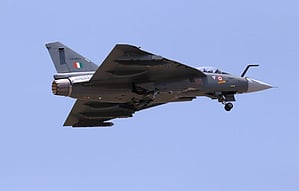Tejas crash at Dubai Airshow 2025: second incident in 24 years raises safety questions
Indian-made jet crashed during a display, marking second known incident in its history

Dubai: A Tejas Mk 1 jet of the Indian Air Force crashed during an aerial display at the Dubai Airshow 2025, killing its pilot. The aircraft, developed by Hindustan Aeronautics Limited (HAL) as India’s indigenous light combat aircraft (LCA), had previously flown without a major accident for almost its entire service life.
Two accidents in 24 years
Although this is widely reported as the 'second crash in 24 years' for the Tejas programme, the timeline is sharper: the first major incident occurred on March 12, 2024, near Jaisalmer, Rajasthan, when a Tejas aircraft crashed during a tri-service exercise and the pilot ejected safely.
Prior to that, the aircraft had maintained an accident-free operational safety record since its first flight in 2001 and induction in 2016.
Similarities and differences
In both incidents, investigations were ordered by the IAF. In the 2025 crash at the Dubai Airshow, the aircraft reportedly performed a negative-G manoeuvre shortly before loss of control. The 2024 Jaisalmer crash, by contrast, was attributed in initial reports to an engine issue (oil-pump failure leading to engine seizure).
Another key difference: in March-2024 the pilot safely ejected and survived; in the November-2025 event the pilot was killed. Additionally, the Dubai Airshow crash occurred in a demonstration context before spectators, raising questions about display flight safety and decision-making under performance pressure.
Aircraft background, programme significance
The Tejas is a single-engine, delta-wing light combat aircraft designed to replace older jets in India’s fighter fleet and to be exported abroad.
With only two crashes over more than two decades of development and service (at least as publicly acknowledged), the programme has emphasised a strong safety record — a claim now being tested. Its role in India’s broader effort to indigenise defence manufacturing adds to the public scrutiny.
Implications and next steps
The IAF has announced a court of inquiry to determine the cause of the Dubai Airshow crash. Investigators will likely examine flight-data recorder information, manoeuvre parameters (especially the negative-G turn), engine performance logs and human-factors aspects of display flight conditions. The outcomes may influence future display-flight protocols, training for demonstration pilots and operational safety procedures for the Tejas fleet.
Moving forward, the crash may affect confidence in the Tejas programme’s international marketing, given that the Dubai event was a global showcase. At the same time, the earlier safe-ejection incident shows the system’s survival mechanisms work. The two incidents together underscore both the risks inherent in high-performance flight and the importance of rigorous investigation.
Network Links
GN StoreDownload our app
© Al Nisr Publishing LLC 2025. All rights reserved.